Measuring Carbon Emissions from Green and Low-Carbon Full-Life-Cycle Feeding in Large-Scale Pig Production Systems: A Case Study from Shaanxi Province, China
Abstract
:1. Introduction
2. Materials and Methods
2.1. Data Source
2.2. Boundary Determination
2.3. Greenhouse Gas Formula for Pig Farming
2.3.1. Greenhouse Gas Emissions from Feed Production, Processing and Transportation
- Greenhouse gases from fodder crop cultivation
- 2.
- Greenhouse gas emissions from feed transportation
2.3.2. Methane Emissions from Enteric Fermentation
2.3.3. CO2 Emissions from Farm Energy Consumption
2.3.4. Greenhouse Gas Emissions from Manure Management
- Greenhouse gases from fodder crop cultivation
- 2.
- Nitrous oxide emissions from manure management
3. Results and Analysis
3.1. Overview of the Basic Conditions of the Farm
3.2. Calculation of Greenhouse Gas Emissions from Feed Production and Transportation
3.2.1. Greenhouse Gas Calculations for Feed Production Processes
3.2.2. Greenhouse Gas Calculations for Feed Transportation Processes
3.3. Calculation of Methane Emissions from Enteric Fermentation of Pigs on Farms
3.4. CO2 Emissions from Farm Energy Consumption
3.5. Calculating Methane Emissions from Manure Management
3.6. Calculating Nitrous Oxide Emissions from Manure Management
3.7. Estimation of Carbon Emissions from the Hog Industry in Shaanxi Province
4. Conclusions
- (1)
- Greenhouse gas emissions from feed production, processing and transportation. The cultivation and processing of primary feed components—corn, soybean meal, and wheat bran—play a pivotal role in the overall greenhouse gas emissions of the hog farming supply chain. Through comparative analysis, data from Pucheng Xinliu Science and Technology, Baoji Zhengneng Farming, and Baoji Zhenghui Farming and Animal Husbandry indicate that for each kilogram of pork produced, the CO2 emissions from feed cultivation amount to 0.68777 kg, 1.19164 kg, and 0.60742 kg, respectively. Notably, CO2 emissions linked to corn and wheat feed production are significantly higher compared to soybeans. A detailed vertical assessment of feed production underlines the pronounced contribution of electricity used in irrigation and drainage, along with nitrogen fertilizer inputs, to the total CO2 emissions. Targeting these areas is thus essential for achieving agricultural carbon reduction objectives. Furthermore, when examining the transportation aspect of feed, CO2 emissions per kilogram of pork produced were found to be 0.11521 kg, 0.33274 kg, and 0.20624 kg for Pucheng Xinliu Technology, Baoji Zhengneng Farming, and Baoji Zhenghui Farming, respectively.
- (2)
- Enteric fermentation methane emissions from pig rearing. In the assessment of large-scale pig farms in Shaanxi Province, the emission factor for enteric fermentation methane in live pigs exceeds the Intergovernmental Panel on Climate Change (IPCC) default values, suggesting a potential underestimation in the region’s methane emission metrics as per the IPCC standards. Detailed analyses indicate an average methane emission factor of 2.61823 kgCH4/head/year for fattening pigs. For breeding pigs, this value rises to 2.96752 kgCH4/head/year. Intriguingly, within identical genetic strains, breeding pigs manifest elevated enteric methane emissions compared to fattening pigs.
- (3)
- Farm energy consumption CO2 emissions. In Shaanxi Province, pig farming operations primarily rely on electricity, which powers essential management tasks such as sanitation, illumination, and climatic adjustments. Our analysis reveals that breeding pigs contribute to annual carbon dioxide emissions of 234.12 kgCO2 each, notably surpassing the 73.02 kgCO2 attributed to fattening pigs. This discrepancy is likely due to the elevated environmental standards—such as temperature and humidity—demanded during the breeding stages. As a result, breeding pigs necessitate more intensive use of environmental control systems, leading to higher electricity consumption.
- (4)
- Methane emissions and nitrous oxide emissions from manure management. Upon consolidating data from three pig farms, we observed that during the nursery phase, fattening pigs contributed an average of 0.01924 kg CH4 per head daily, while during their fattening period, the methane emission surged to 0.28111 kg per head daily. For breeding pigs, methane emissions across various stages were as follows: fattening, 0.03391 kg; nursery, 0.18583 kg; reserve, 0.09884 kg; gestation, 0.20223 kg; and lactation, 0.62378 kg per head daily. In terms of nitrous oxide (N2O) emissions, during the nursery and fattening phases of fattening pigs, the emissions were 0.00087 kg and 0.00294 kg per head daily, respectively. For breeding pigs, the N2O emissions across stages were as follows: fattening, 0.00130 kg; nursery, 0.00267 kg; reserve, 0.00267 kg; gestation, 0.00289 kg; and lactation, 0.00706 kg per head daily. It is worth noting that within a singular enterprise using consistent manure treatment methods, the methane and nitrous oxide emissions from breeding pigs during the fattening, reserve, and gestation phases were comparable. Significantly, the daily methane and nitrous oxide emissions from lactating pigs markedly surpassed those from other stages of rearing.
- (5)
- Our study assessed carbon emissions from pig breeding, contrasting the Pucheng and Baoji models, and subsequently quantified the cumulative carbon footprint of Shaanxi’s swine sector. Under the Pucheng model, the carbon emissions for fattening and breeding pigs were determined to be 328.5283 kg and 539.2060 kg, respectively. When carrying out this model across the province in 2021, it is projected to result in carbon emissions of 2.629 × 109 kg for fattening pigs and 4.59 × 108 kg for breeding pigs. Conversely, the Baoji model exhibited a carbon footprint of 249.2897 kg for each fattening pig and 551.6733 kg for each breeding pig. With province-wide adoption of the Baoji model in 2021, the estimated emissions for fattening pigs would decrease to 1.995 × 109 kg, whereas breeding pigs would witness a marginal rise to 4.69 × 108 kg. Critically, maintaining consistent supply levels while decreasing fattening pig production could play a pivotal role in substantially curtailing the carbon emissions of the swine sector in Shaanxi Province.
5. Discussion
6. Policy Recommendations
Supplementary Materials
Author Contributions
Funding
Institutional Review Board Statement
Data Availability Statement
Acknowledgments
Conflicts of Interest
References
- Xue, Y.; Luan, W.; Wang, H.; Yang, Y. Environmental and economicbenefits of carbon emission reduction in animal husbandry viathe circular economy: Case study of pig farming in Liaoning. J. Clean. Prod. 2019, 238, 117968. [Google Scholar] [CrossRef]
- Tian, Y.; Wang, R.; Yin, M.; Zhang, H. Study on the Measurement and Influencing Factors of Rural Energy Carbon Emission Efficiency in China: Evidence Using the Provincial Panel Data. Agriculture 2023, 13, 441. [Google Scholar] [CrossRef]
- He, K.; Li, L.; Liu, Y. Green Development of Livestock and Poultry Farming under the “Double Carbon” Target. Environ. Prot. 2022, 16, 28–33. (In Chinese) [Google Scholar]
- Huang, X.; Xu, X.; Wang, Q.; Zhang, L.; Gao, X.; Chen, L. Assessment of agricultural carbon emissions and their spatiotemporal changes in China, 1997–2016. Int. J. Environ. Res. Public Health 2019, 16, 3105. [Google Scholar] [CrossRef]
- Jin, S.; Liu, Y.; Niu, K. Driving green transformation of agriculture with low carbon: Characteristics of agricultural carbon emissions and its emission reduction path in China. Reform 2021, 5, 29–37. [Google Scholar]
- Li, J.; Li, Q.; Liu, L. Carbon emissions from smallholder pig production in China: A precise account based on farmers’ survey. Environ. Sci. Pollut. Res. 2021, 29, 25651–25664. [Google Scholar] [CrossRef]
- Zhang, Z. Research on Greenhouse Gas Emission Accounting Methods for Hog Farming Enterprises. Master’s Thesis, Beijing Architecture University, Beijing, China, 2018. (In Chinese). [Google Scholar]
- Gerber, P.J.; Steinfeld, H.; Henderson, B.; Opio, C.; Dijkman, J.; Falcucci, A.; Tempio, G. Tackling Climate Change through Livestock: A Global Assessment of Emissions and Mitigation Opportunities; Food and Agriculture Organization of the United Nations (FAO): Rome, Italy, 2013. [Google Scholar]
- Yao, C.; Qian, S.; Li, Z.; Liang, L. Provincial animal husbandry carbon emissions in China and temporal-spatial evolution mechanism. Resour. Sci. 2017, 4, 698–712. [Google Scholar]
- Zhang, J.; He, K. Research on low-carbon development of agriculture under the “dual-carbon” goal: Current situation, misconceptions and prospects. J. Agric. Econ. Issues 2022, 9, 35–46. (In Chinese) [Google Scholar]
- Yang, T.; Li, F.; Du, M.; Wang, Y.; Sun, Z. Measuring pollutant emissions of cattle breeding and its spatial-temporal variation in China. J. Environ. Manag. 2021, 299, 113615. [Google Scholar] [CrossRef]
- Tian, W.; Yu, H.; Wu, X. Estimation of the scale of moderate pig breeding from the perspective of pollution control cost: Based on the survey of Sichuan pig transfer county. Rural. Econ. 2019, 3, 122–127. [Google Scholar]
- Xu, X.; Lan, Y. A comparative study on carbon footprints between plant- and animal-based foods in China. J. Clean. Prod. 2016, 112, 2581–2592. [Google Scholar] [CrossRef]
- Wang, H.; Qiao, J. An economic analysis of the changes in the distribution of pig production in China. Econ Geogr. 2017, 37, 129–136. [Google Scholar]
- Guo, H.; Li, S.; Pan, C.; Lei, Q. Analysis of spatial and temporal characteristics of carbon emission efficiency of pig farming and the influencing factors in China. Front. Public Health 2023, 11, 1073902. [Google Scholar] [CrossRef] [PubMed]
- Pirlo, G.; Carè, S.; Della, C.G.; Marchetti, R.; Ponzoni, G.; Faeti, V.; Fantin, V.; Masoni, P.; Buttol, P.; Zerbinatti, L.; et al. Environmental impact of heavy pig production in a sample of Italian farms. A cradle to farm-gate analysis. Sci. Total Environ. 2016, 565, 576–585. [Google Scholar] [CrossRef] [PubMed]
- Zhou, Y.; Dong, H.; Xin, H.; Zhu, Z.; Huang, W.; Wang, Y. Carbon footprint assessment of a large-scale pig production system in northern China: A case study. Trans. ASABE 2018, 3, 1121–1131. [Google Scholar] [CrossRef]
- Yang, S.; Liu, C.; Liu, Y. Estimation of methane and nitrous oxide emission from animal production sector in Taiwan during 1990–2000. Chemosphere 2003, 9, 1381–1388. [Google Scholar] [CrossRef]
- Vergé, X.P.C.; Dyer, J.A.; Desjardins, R.L.; Worth, D. Greenhouse gas emissions from the Canadian beef industry. Agric. Syst. 2008, 2, 126–134. [Google Scholar] [CrossRef]
- Nguyen, T.L.T.; Hermansen, J.E.; Mogensen, L. Environmental consequences of different beef production systems in the EU. J. Clean. Prod. 2010, 8, 756–766. [Google Scholar] [CrossRef]
- Noya, I.; Aldea, X.; Gasol, C.M.; González-García, S.; Amores, M.J.; Colón, J.; Ponsá, S.; Roman, I.; Rubio, M.A.; Casas, E.; et al. Carbon and water footprint of pork supply chain in Catalonia: From feed to final products. J. Environ. Manag. 2016, 171, 133–143. [Google Scholar] [CrossRef] [PubMed]
- MacLeod, M.; Gerber, P.; Mottet, A.; Tempio, G.; Falcucci, A.; Opio, C.; Vellinga, Y.; Henderson, B.; Steinfeld, H. Greenhouse Gas Emissions from Pig and Chicken Supply Chains–A Global Life Cycle Assessment; Food and Agriculture Organization of the United Nations: Rome, Italy, 2013. [Google Scholar]
- González-García, S.; Belo, S.; Dias, A.C.; Rodrigues, J.V.; Costa, R.R.; Ferreira, A.; Andrade, L.P.; Arroja, L. Life cycle assessment of pigmeat production: Portuguese case study and proposal of improvement options. J. Clean. Prod. 2015, 100, 126–139. [Google Scholar] [CrossRef]
- Gutiérrez, A.S.; Eras, J.C.; Billen, P.; Vandecasteele, C. Environmental assessment of pig production in Cienfuegos, Cuba: Alternatives for manure management. J. Clean. Prod. 2016, 112, 2518–2528. [Google Scholar] [CrossRef]
- Duan, H.; Zhang, Y.; Zhao, J. Carbon footprint analysis of farmland ecosystem in China. J. Soil Water Conserv. 2011, 6, 203–208. [Google Scholar]
- Liao, Y. Calculation of Carbon Emissions in the Production Process of Large-Scale Pig Farms. Master’s Thesis, Nanchang University, Nanchang, China, 2011. (In Chinese). [Google Scholar]
- Mogensen, L.; Kristensen, T.; Nguyen, T.L.T.; Knudsen, M.T.; Hermansen, J.E. Method for calculating carbon footprint of cattle feeds–including contribution from soil carbon changes and use of cattle manure. J. Clean. Prod. 2014, 73, 40–51. [Google Scholar] [CrossRef]
- Si, B.; Wang, C.; Cheng, S.; Ma, X.; Xu, W.; Wang, Z.; Li, B.; Wang, Y.; Shi, Z.; Jiang, W. Carbon and water footprint analysis of pig farm buildings in Northeast China using building-information-modeling enabled assessment. Sci. Total Environ. 2023, 888, 164088. [Google Scholar] [CrossRef]
- Li, Q.; Gao, M.; Li, J. Carbon emissions inventory of farm size pig husbandry combining Manure-DNDC model and IPCC coefficient methodology. J. Clean. Prod. 2021, 320, 128854. [Google Scholar] [CrossRef]
- Wang, X.; Dong, X.; Wang, X.; Zhang, P.; Liu, R.; Klemeš, J.J.; Zheng, J. A life cycle assessment of an enterprise’s low-carbon emissions model: The Xinjiang Shihezi pig farm faecal treatment biogas project as a case study. J. Environ. Manag. 2022, 304, 114251. [Google Scholar] [CrossRef]
- Garcia-Launay, F.; Van der Werf, H.M.G.; Nguyen, T.T.H.; Dourmad, J.Y. Evaluation of the environmental implications of the incorporation of feed-use amino acids in pig production using Life Cycle Assessment. Livest. Prod. Sci. 2014, 161, 158–175. [Google Scholar] [CrossRef]
- Hu, X.; Wang, J. Estimation of livestock greenhouse gases discharge in China. Trans. Chin. Soc. Agric. Eng. 2010, 10, 247–252. [Google Scholar]
- Zhou, Y. Carbon Footprint Assessment Methodology and Case Study of Large-Scale Pig Farming in China. Ph.D. Thesis, Chinese Academy of Agricultural Sciences, Beijing, China, 2019. (In Chinese). [Google Scholar]
- Chen, S.; Lu, F.; Wang, X. Estimation of greenhouse gas emission coefficients for nitrogen, phosphorus and potassium fertilizer manufacturing in China. J. Ecol. 2015, 19, 6371–6383. (In Chinese) [Google Scholar]
- Basset-Mens, C.; van der Werf, H.M.G. Scenario-based environmental assessment of farming systems: The case of pig production in France. Agric. Ecosyst. Env. 2005, 105, 127–144. [Google Scholar] [CrossRef]
- Cederberg, C. Greenhouse Gas Emissions from Swedish Consumption of Meat, Milk and Eggs 1990 and 2005; SIK Institutet för Livsmedel och Bioteknik: Göteborg, Sweden, 2009. [Google Scholar]
- Kool, A.; Blonk, H.; Ponsioen, T.; Sukkel, W.; Vermeer, H.; Vries, H. Carbon Footprints of Conventional and Organic Pork: Assessments of Typical Production Systems in The Netherlands, Denmark, England and Germany; Blonk Milieu Advies: Gouda, The Netherlands, 2009. [Google Scholar]
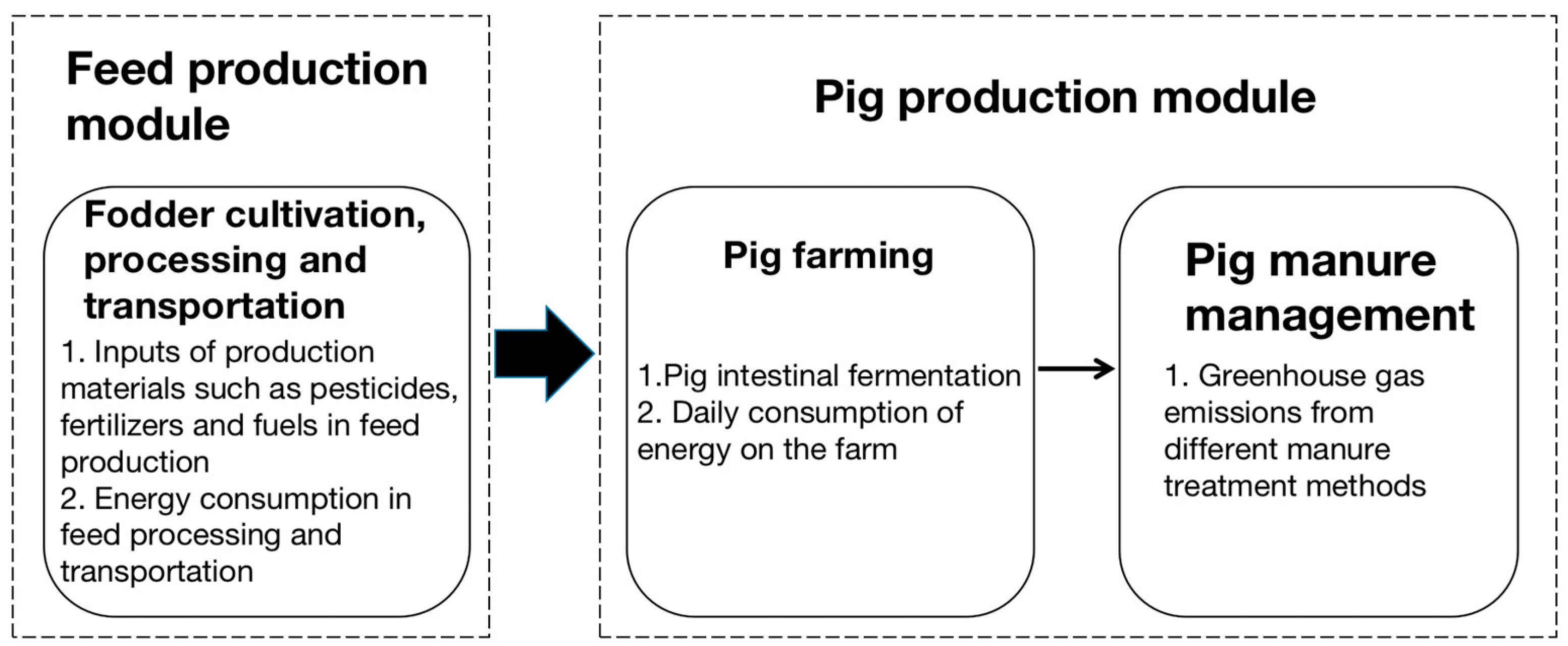


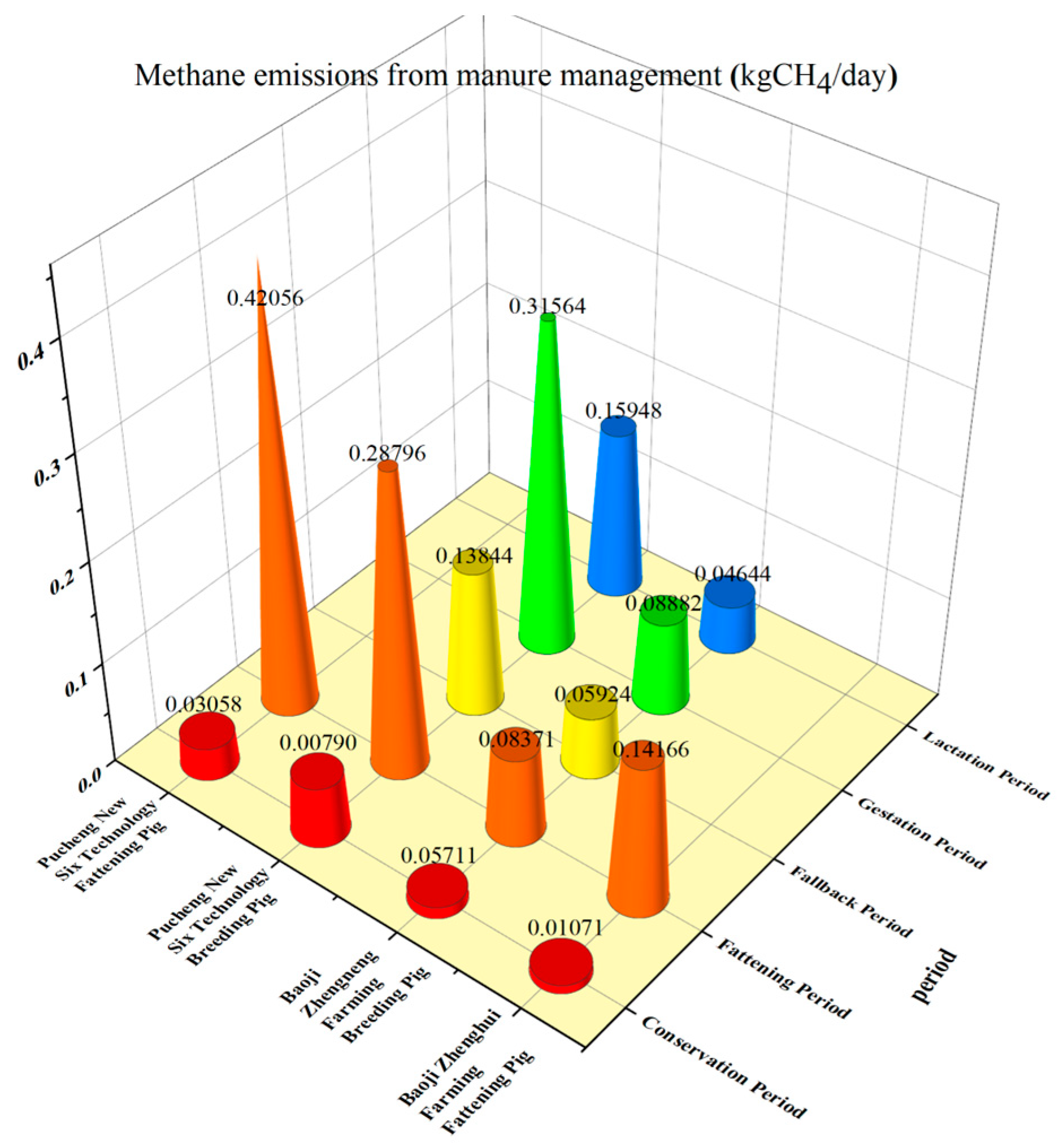
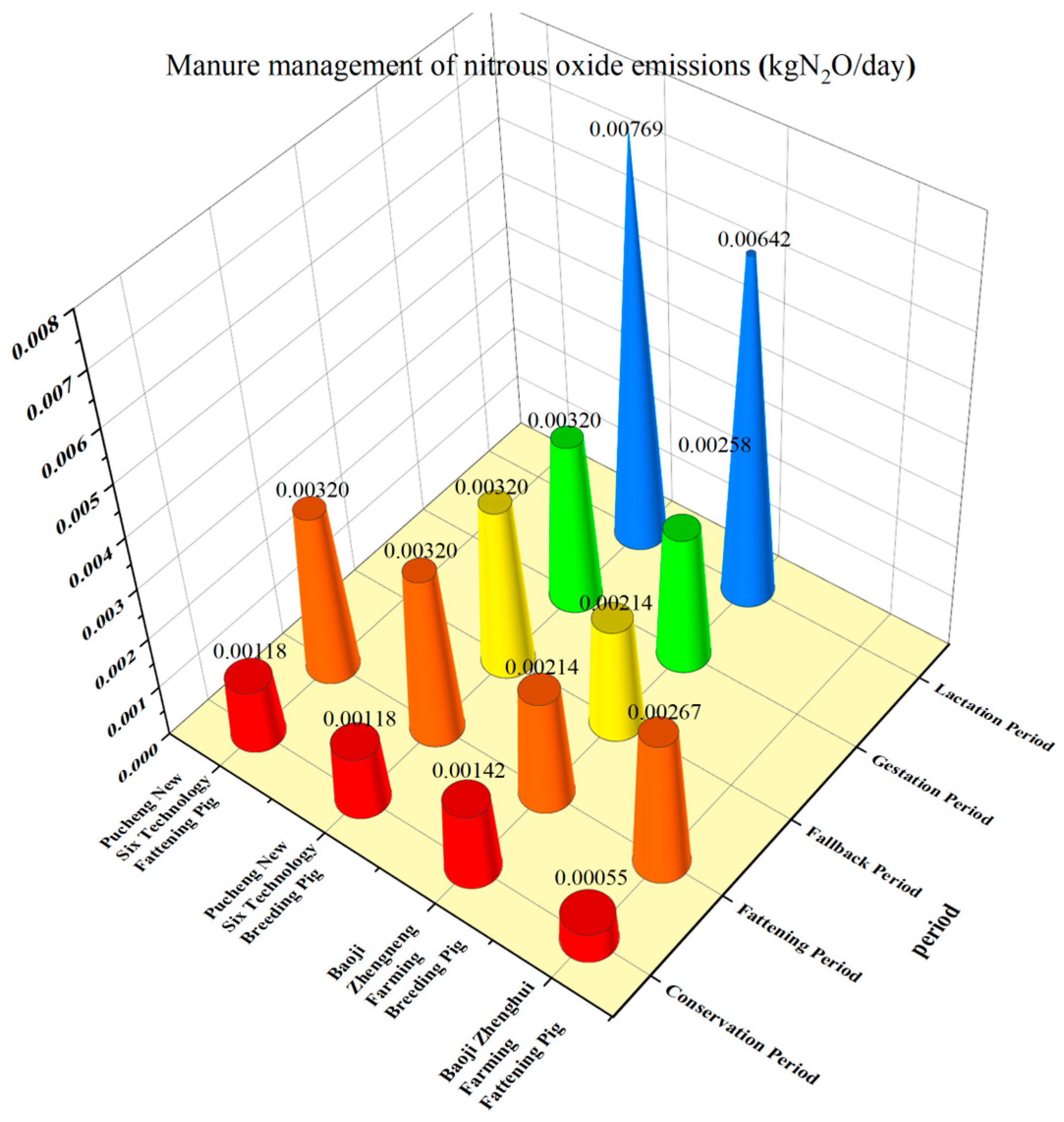
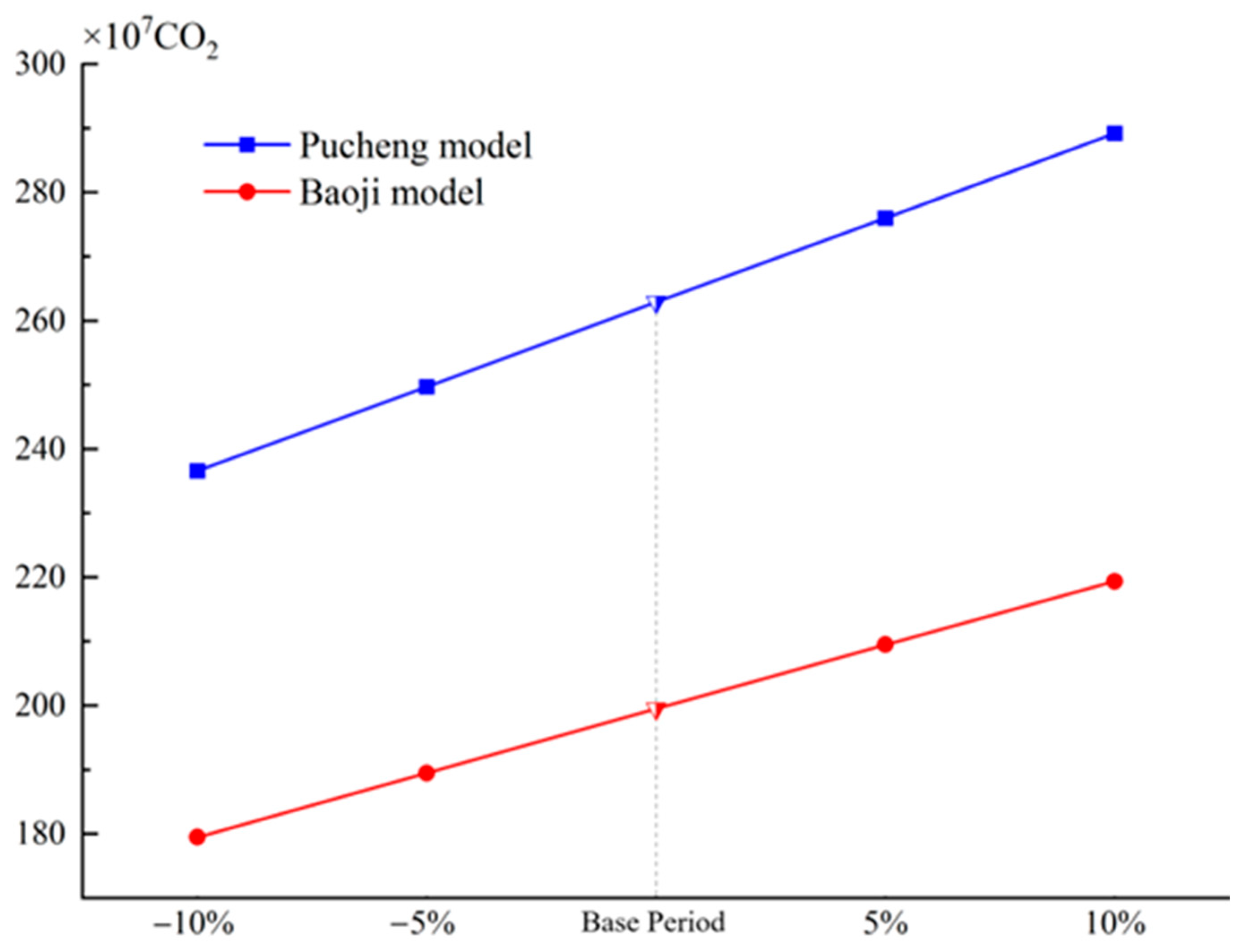
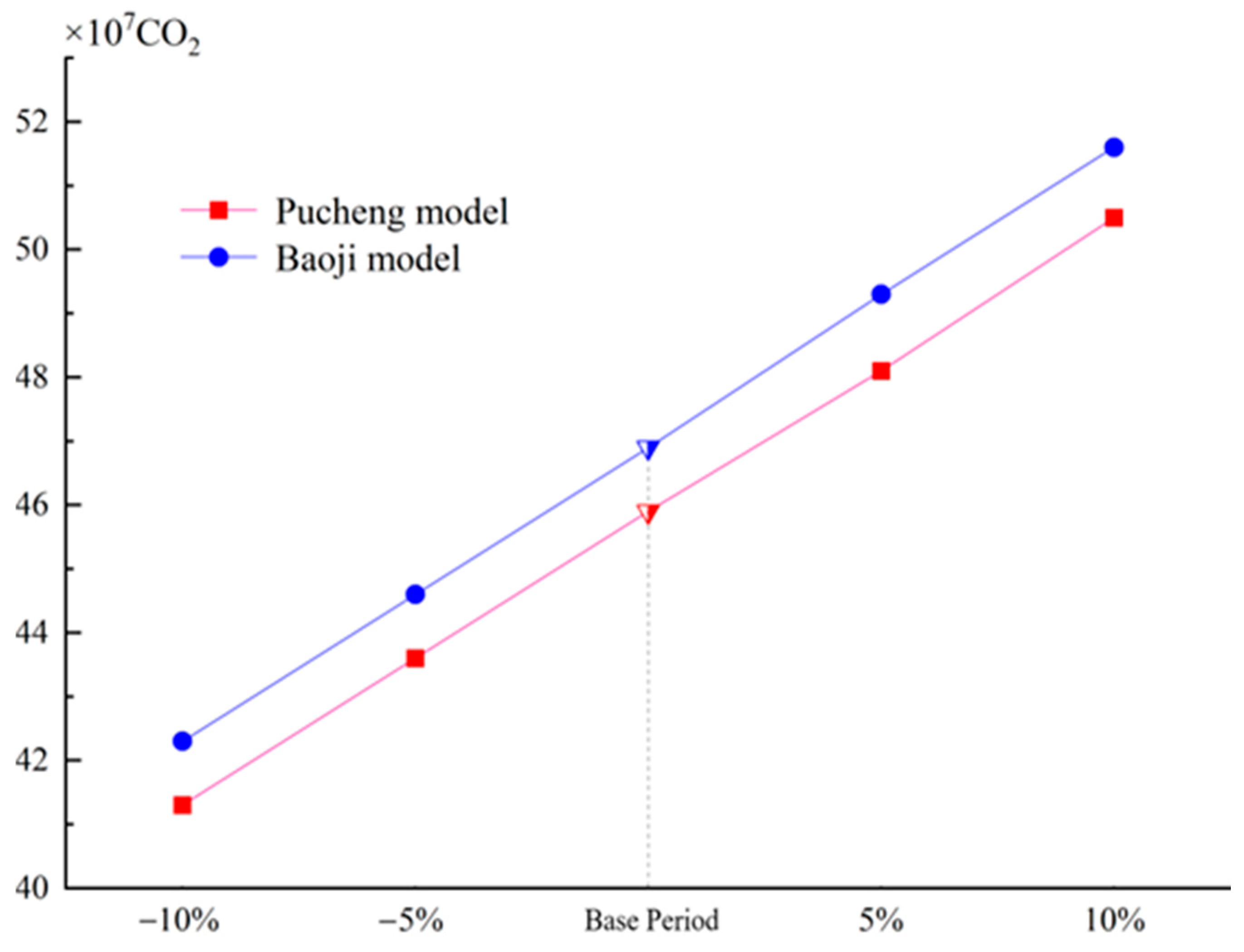
| Pig Fattening | Breed | Average Annual Stock/Head | Average Annual Output/Head | Average Weight at Barn/kg |
|---|---|---|---|---|
| Pucheng New Six Technology | PIC | 24,000 | 300,000 | 120 |
| Baoji Zhengneng Farming | none | none | none | none |
| Baoji Zhenghui Farming | Binary Pig | 11,500 | 24,000 | 110 |
| Pig Breeding | Breed | Average Annual Stock/Head | Average Annual Output/Head | Average Weight at Barn/kg |
|---|---|---|---|---|
| Pucheng New Six Technology | PIC | 24,000 | 300,000 | 120 |
| Baoji Zhengneng Farming | Binary Pig | 5360 | none | none |
| Baoji Zhenghui Farming | none | none | none | none |
| Pig Fattening | Total Feeding Period | Conservation Period Days and Average Daily Feed Intake kg/Head | Number of Days of Fattening Period and Average Daily Feed Intake kg/Head |
|---|---|---|---|
| Pucheng New Six Technology | 180 day | 30 day, 0.9 kg | 150 day, 2.5 kg |
| Baoji Zhengneng Farming | none | none | none |
| Baoji Zhenghui Farming | 140 day | 30 day, 0.5 kg | 110 day, 2.5 kg |
| Pig Breeding | Total Feeding Period | Days of Conservation and Average Daily Feed Intake kg/Head | Fattening Days and Average Daily Feed Intake kg/Head | Days to Reserve and Average Daily Feed Intake kg/Head | Gestation Days and Average Daily Feed Intake kg/Head | Lactation Days and Average Daily Feed Intake kg/Head |
|---|---|---|---|---|---|---|
| Pucheng New Six Technology | 348 day | 56 day, 0.9 kg | 104 day, 2.5 kg | 50 day, 2.5 kg | 114 day, 2.5 kg | 24 day, 6.0 kg |
| Baoji Zhengneng Farming | 385 day | 25 day, 1.3 kg | 130 day, 2.0 kg | 92 day, 2.0 kg | 114 day, 2.42 kg | 24 day, 6.01 kg |
| Baoji Zhenghui Farming | none | none | none | none | none | none |
| Measurement Indicators | Corn | Soybeans | Wheat | |
|---|---|---|---|---|
| Yield per unit (kg/mu 1) | 502.62 | 133.56 | 430.33 | |
| Proportion of crops processed for feedstock (ratio (%)) | 55 | 82 | 28 | |
| Fertilizer application rate (kg/mu) | 24.97 | 8.46 | 28.33 | |
| Amount of agricultural film applied (kg/mu) | 0.37 | 0 | 0 | |
| Discounted fertilizer use per mµ (kg/mu) | Nitrogen fertilizer (kg/mu) | 6.46 | 1.02 | 7.73 |
| Phosphate fertilizer (kg/mu) | 0.20 | 0.10 | 0.24 | |
| Potash fertilizer (kg/mu) | 0.14 | 0.48 | 0.02 | |
| Compound fertilizer (kg/mu) | 18.18 | 6.85 | 20.33 | |
| Pesticide application rate (kg/mu) | Pesticide fee (CNY/mu) | 19.54 | 18.61 | 28.31 |
| Average pesticide prices (CNY/kg) | 86.31 | |||
| Pesticide application rate per acre (kg/mu) | 0.23 | 0.22 | 0.33 | |
| Diesel inputs (kg/mu) | Fuel and power costs (CNY/mu) | 0.58 | 0.25 | 1.01 |
| Price of diesel oil (CNY/kg) | 5.544 | |||
| Diesel fuel consumption per mu (kg/mu) | 0.10 | 0.05 | 0.18 | |
| Electricity consumption for drainage and irrigation (kwh/mu) | Irrigation and drainage fees (CNY/mu) | 16.79 | 1.11 | 33.24 |
| Water bill (CNY/mu) | 6.14 | 0.09 | 5.28 | |
| Electricity prices for irrigation and drainage (CNY/kwh) | 0.2974 | |||
| Electricity consumption for drainage and irrigation (kwh/mu) | 35.81 | 3.43 | 94.01 | |
| Project | Value | Unit |
|---|---|---|
| Nitrogen fertilizer | 2.12 | kgCO2/kg |
| Phosphate fertilizer | 0.64 | kgCO2/kg |
| Potash fertilizer | 0.18 | kgCO2/kg |
| Compound fertilizer | 0.07 | kgCO2/kg |
| Agro-film | 22.72 | kgCO2/kg |
| Agrochemicals | 12.44 | kgCO2/kg |
| Coals | 1.98 | kgCO2/kg |
| Diesel fuel | 3.16 | kgCO2/kg |
| Grids | 0.67 | kgCO2/kWh |
| Pucheng New Six Technology (kgCO2/kg) | Corn | Soybeans | Wheat | Total |
|---|---|---|---|---|
| Agro-film | 0.05462 | 0 | 0 | 0.05462 |
| Agrochemical | 0.01859 | 0.00711 | 0.01618 | 0.04188 |
| Nitrogen fertilizer | 0.08898 | 0.00562 | 0.06461 | 0.15921 |
| Phosphate fertilizer | 0.00083 | 0.00022 | 0.00060 | 0.00165 |
| Potash fertilizer | 0.00017 | 0.00023 | 0.00001 | 0.00041 |
| Compound fertilizer | 0.00827 | 0.00125 | 0.00562 | 0.01514 |
| Diesel fuel | 0.00205 | 0.00038 | 0.00224 | 0.00467 |
| Grids | 0.15589 | 0.00597 | 0.24833 | 0.41019 |
| Total | 0.3294 | 0.02078 | 0.33759 | 0.68777 |
| Baoji Zhengneng Farming (kgCO2/kg) | Corn | Soybeans | Wheat | Total |
|---|---|---|---|---|
| Agro-film | 0.09464 | 0 | 0 | 0.09464 |
| Agrochemical | 0.03221 | 0.01232 | 0.02803 | 0.07256 |
| Nitrogen fertilizer | 0.15418 | 0.00973 | 0.11194 | 0.27585 |
| Phosphate fertilizer | 0.00143 | 0.00037 | 0.00104 | 0.00284 |
| Potash fertilizer | 0.00029 | 0.00039 | 0.00002 | 0.0007 |
| Compound fertilizer | 0.01432 | 0.00216 | 0.00973 | 0.02621 |
| Diesel fuel | 0.00355 | 0.00067 | 0.00388 | 0.00810 |
| Grids | 0.27011 | 0.01034 | 0.43029 | 0.71074 |
| Total | 0.57073 | 0.03598 | 0.58493 | 1.19164 |
| Baoji Zhenghui Farming (kgCO2/kg) | Corn | Soybeans | Wheat | Total |
|---|---|---|---|---|
| Agro-film | 0.04824 | 0 | 0 | 0.04824 |
| Agrochemical | 0.01642 | 0.00628 | 0.01429 | 0.03699 |
| Nitrogen fertilizer | 0.07859 | 0.00496 | 0.05706 | 0.14061 |
| Phosphate fertilizer | 0.00073 | 0.00019 | 0.00053 | 0.00145 |
| Potash fertilizer | 0.00015 | 0.00020 | 0.00001 | 0.00036 |
| Compound fertilizer | 0.00730 | 0.00110 | 0.00496 | 0.01336 |
| Diesel fuel | 0.00181 | 0.00034 | 0.00198 | 0.00413 |
| grids | 0.13768 | 0.00527 | 0.21933 | 0.36228 |
| Total | 0.29092 | 0.01834 | 0.29816 | 0.60742 |
| CO2 Emissions from Feed Transportation | Feed Annual Feed Consumption (t) | Transportation Distance (km) | Annual CO2 Emissions (kg) | CO2 Emissions per kg of Pork (kg) |
|---|---|---|---|---|
| Pucheng New Six Technology | 27,000 | 87.5 | 497,700 | 0.11521 |
| Baoji Zhengneng Farming | 6120 | 166 | 214,020 | 0.33274 |
| Baoji Zhenghui Farming | 6192 | 200 | 260,889 | 0.20624 |
| Enteric Fermentation Methane Emissions | Pig Fattening kgCH4/kg | Pig Fattening kgCH4/Heads/Year | Pig Breeding kgCH4/kg | Pig Breeding kgCH4/Heads/Year |
|---|---|---|---|---|
| Pucheng New Six Technology | 0.01122 | 2.69212 | 0.02419 | 2.90270 |
| Baoji Zhengneng Farming | None | None | 0.02527 | 3.03233 |
| Baoji Zhenghui Farming | 0.00887 | 2.54434 | None | None |
| Company Identification | Pucheng New Six Technology | Baoji Zhengneng Farming | Baoji Zhenghui Farming |
|---|---|---|---|
| Total purchased electricity KWh/year | 1,387,000 | 1,406,511 | 941,172 |
| Energy consumption CO2 emissions kgCO2/KWh | 123,748.14 | 1,254,889.11 | 839,713.66 |
| Carbon dioxide produced per pig per year kgCO2 | none | 234.12 | 73.02 |
| Manure Management Practices | Oxidation Pond | Fuel Combustion | Solid Storage | Uncovered Anaerobic Pond | Compostable | Direct Fertilization | Fermenter |
|---|---|---|---|---|---|---|---|
| MCF (%) | 71 | 10 | 4 | 77 | 0.8 | 0.5 | 10 |
| Manure Management Practices | Compostable | Direct Fertilization | Fermenter |
|---|---|---|---|
| 0.006 | 0.005 | 0.006 |
Disclaimer/Publisher’s Note: The statements, opinions and data contained in all publications are solely those of the individual author(s) and contributor(s) and not of MDPI and/or the editor(s). MDPI and/or the editor(s) disclaim responsibility for any injury to people or property resulting from any ideas, methods, instructions or products referred to in the content. |
© 2023 by the authors. Licensee MDPI, Basel, Switzerland. This article is an open access article distributed under the terms and conditions of the Creative Commons Attribution (CC BY) license (https://creativecommons.org/licenses/by/4.0/).
Share and Cite
Zhang, Q.; Liao, H.; Yang, H.; Liu, M.; Jia, S.; Li, H. Measuring Carbon Emissions from Green and Low-Carbon Full-Life-Cycle Feeding in Large-Scale Pig Production Systems: A Case Study from Shaanxi Province, China. Agriculture 2023, 13, 2281. https://doi.org/10.3390/agriculture13122281
Zhang Q, Liao H, Yang H, Liu M, Jia S, Li H. Measuring Carbon Emissions from Green and Low-Carbon Full-Life-Cycle Feeding in Large-Scale Pig Production Systems: A Case Study from Shaanxi Province, China. Agriculture. 2023; 13(12):2281. https://doi.org/10.3390/agriculture13122281
Chicago/Turabian StyleZhang, Qingsong, Haoling Liao, Honghong Yang, Mengmeng Liu, Suobin Jia, and Hua Li. 2023. "Measuring Carbon Emissions from Green and Low-Carbon Full-Life-Cycle Feeding in Large-Scale Pig Production Systems: A Case Study from Shaanxi Province, China" Agriculture 13, no. 12: 2281. https://doi.org/10.3390/agriculture13122281
APA StyleZhang, Q., Liao, H., Yang, H., Liu, M., Jia, S., & Li, H. (2023). Measuring Carbon Emissions from Green and Low-Carbon Full-Life-Cycle Feeding in Large-Scale Pig Production Systems: A Case Study from Shaanxi Province, China. Agriculture, 13(12), 2281. https://doi.org/10.3390/agriculture13122281





